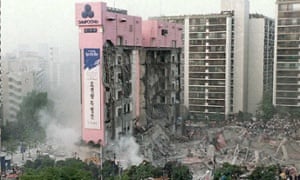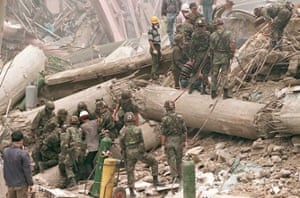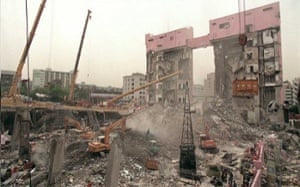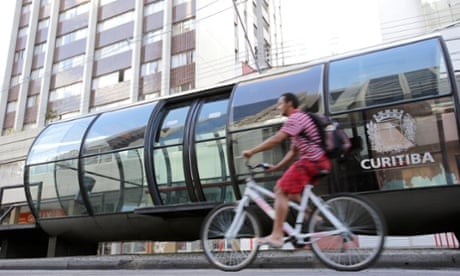Learning from Seoul's Sampoong Department Store disaster – a history of cities in 50 buildings, day 44
After a string of ill-considered decisions led to the collapse of Seoul’s luxury department store and the death of 502 people in 1995, the disaster continues to offers an important lesson to other cities urbanising at such an impressive pace

Observers tend to describe the rise of South Korea as a miracle, and the actual story makes the word seem only a minor exaggeration. Having emerged an utter wreck from the Korean War in the early 1950s, by the 21st century the country had become a rich, infrastructurally impressive, technologically forward-thinking global economic and cultural force. But South Korea’s unprecedentedly rapid entry into the first world has taken its tolls, and no one event of its dizzying 20th-century period of growth forced as many of its people to face them as the collapse of the Sampoong Department Store.
Those who endured the hardships of the Korean War and its aftermath had to welcome whatever prosperity the future could bring, despite the repression of the dictators who oversaw it and the grinding nature of a national life rigorously dedicated to nation-building. But from the 1970s through to the early 1990s, even the most development-minded Korean couldn’t help but suspect that something had gone wrong. An apartment block falls to the ground, a hotel catches fire, a train station explodes, a bridge collapses: the built environment that had risen so recently and triumphantly around them had already begun to crumble.
From the beginning, South Korea has understood that development and urbanisation go hand in hand. In fact, it understands that almost too well, resulting in what ranks today as one of the most capital-centric countries in the world. The resources it has devoted to Seoul make the rest of South Korea seem almost like a mere support system for that 24-hour high-rise megalopolis of 25 million people, built over the rubble of the modest Japanese colonial city it had been before the second world war.
The creation of postwar Seoul involved plenty of rebuilding, but even more new building. The “old” city lies north of the Han River, which runs through Seoul much as the Thames does London. On the Han’s other side, the area known as Gangnam (literally, “south of the river”), made famous in recent years by pop music and television dramas, has grown since the 1970s as a deliberately designed hub of private affluence, corporate investment, and skyline-defining towers – a concrete advertisement for just how far up South Korea has come in the world.
A former landfill in Gangnam’s especially wealthy district of Seocho made the perfect location for the upscale Sampoong Department Store. Construction on this bright pink symbol of Seoul’s advanced consumer culture began in 1987, the year South Korea became a democracy and the year before the modernised country made its debut on the world stage by hosting the Olympic Games.

But it didn’t enter construction as a department store: the original plan called for a large four-storey apartment complex. After work had already begun, owner Lee Joon, in the first of many ill-considered decisions, switched the project from a residential one to a commercial one, a conversion which necessitated the removal of support columns to make room for escalators. When the contractors balked at this, Lee exchanged them for a more obedient in-house crew.
Using a building of this size entirely as a department store went against zoning regulations, which Lee circumvented by ordering the addition of a skating rink on an originally unplanned-for fifth floor. Again, when the first building company he hired advised against such a structure-compromising modification, he simply sacked them. The firm that did build the fifth floor even went along when he changed his mind once again, turning it into a gallery of restaurants heated by a system of under-floor hot-water pipes, increasing the stress on the already overburdened columns remaining.
Still, the Sampoong Department Store might stand today if not for the air-conditioning machinery installed on top. When tenants of neighbouring buildings to the east complained about the noise it made, management moved the three units to the west, not by lifting them with cranes, but by dragging them – their combined 45-tonne weight four times what the building was designed to handle – all the way across the roof. This opened up cracks that widened each and every morning the air conditioners clicked on and vibrated to life over the next two years.
Then came the morning of 29 June 1995. The structure’s visible cracks had widened alarmingly and continued to do so as the day wore on, provoking enough concern to force two executive decisions: first, to switch off the air conditioning, and second, to close the top floor. But Lee refused to evacuate the day’s unusually large and lucrative shopping crowd, and so in the store they remained at 5:52 pm, when the air-conditioning units fell through the roof and the support columns gave way, resulting in the deadliest building collapse since antiquity.

More than 500 people died in the Sampoong Department Store – not because of a gas explosion or a North Korean bomb (two early suspicions) – but because ofsheer negligence in construction and maintenance of a building not yet six years old. As the facts emerged, Lee and his associates became the most reviled men in South Korea, not just for their own actions (most damningly, their selective evacuation of Sampoong’s executives from the building, hours before the collapse) but for the shameful strain they represented in the country’s modern history: their reckless corner-cutting, bribery and irresponsibility, far from isolated tendencies, had become endemic in a society desperate to develop as rapidly as possible, a sensibility which renders the law nothing more than an obstacle to prosperity.
“Endless Disaster, Disaster, Disaster,” declared one local headline in the wake of the Sampoong collapse. Not only had the public caught on to that pattern, but the investigation of the Sampoong Group and the government officials with which they dealt threw light on a staggering depth and breadth of corruption. Worse still, the thoroughgoing inspection of Seoul’s by then proudly characteristic towers found that one out of seven needed rebuilding, four out of five needed major repairs, and just one in 50 could qualify as safe.
“People should do their best at their jobs,” said Jeong Gwang-jin, a prominent lawyer who lost three daughters in the Sampoong Department Store. “This accident happened because they didn’t.” The prioritisation of size and quantity over safety and quality demanded by South Korea’s ideology of accelerated nation-building, expressed as a practice of accelerated city-building, visited this resoundingly third-world accident on Seoul’s newly minted upper-middle class.
And Lee, born in 1922, would have come of age in a time when Korea was a land that still relied to a great extent on horse carts and thatched roofs, one where nobody considered the prospect of opulent shopping complexes, let alone of the prospect of opulent shopping complexes suddenly falling down. Like most of South Korea’s ruling class in the 1970s and 1980s, Lee found himself in a position of power in a reality almost incomprehensibly different from any he’d known before, with a mandate only to generate wealth, and he made decisions that reflected his circumstances.
The story offers a lesson to all the cities currently and dramatically expanding in developing countries over the world, most notably China, where the impressive and frightening aspects of South Korea’s development now play out on a larger scale and shorter timeline. It also continues to offer a valuable lesson for South Korea. Despite the insistence that a Sampoong Department Store must never happen again, a similar disaster did indeed happen again: last year, this time at sea rather than in the city. On 16 April 2014, 304 passengers, many of them high school students, died in the sinking of the badly overloaded, procedurallyunprepared MV Sewol, a tragedy which echoed not just Sampoong but the earlier MV Seohae, another ferry which claimed 292 lives when it went under in 1993.
On the whole, South Korea has built a formidable city in Seoul, and one that will serve ably as a model for other countries looking to craft world-class urban environments of their own. If a living city is a changing city, Seoul counts as one of the most intensely city-like cities going today. Seoul seems to remain in a constant state of architectural and infrastructural metamorphosis – and not always because pieces have fallen off. But that constant revision of the built environment can also feel like an erasure of history. Visit the site of the Sampoong Department Store, and you’d never guess what happened there almost exactly 20 years ago – a luxury apartment complex now stands in its place.
- Which other buildings in the world tell stories about urban history? Share your own pictures and descriptions with GuardianWitness, on Twitter and Instagram using #hoc50 or let us know suggestions in the comments below






No comments:
Post a Comment
Note: Only a member of this blog may post a comment.